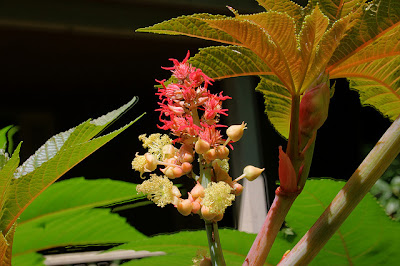A Caster Bean Plant
A plant that appears green and a little unique in appearance easily hides the potent toxicity behind it. Like all the others, its fresh star shaped leaves often invite many passing herbivores – no wonder many animals stop to ingest and the danger behind these plants are too well hidden to be seen. Resting with the most Deadliest Plant toxin in the world – 6, 0000 times more noxious than cyanide, this plant has been known as a ‘wonder plant’ for thousands of years and you may know it as the Caster Bean plant.The caster bean plant is a fast –growing suckering perennial shrub which often reaches the size of small trees (39 feet). The glossy leaves vary from a reddish tinge, to dark green and a reddish purple and sit amongst the fruit capsules and varieties of flowers that line across the leaves in twists of red, green and yellow. Doesn’t sound so harmful does it? The secret of their dangerous poison lays not in the leaves, not in the stem but where they can disperse of them the most – their seeds!
Over 50% of the plant is comprised of rich oil – and to assist is a remarkable anti- predatory evolution substance of ricin – a protein toxic to almost every species in the animal kingdom. If the poison is to become ingested by any passing hungry species, it inactivates the key protein making elements of a cell – a vital component for cells to maintain themselves, so without it – many cells in the animal die, resulting in a domino wave and eventually killing the consumer.
The toxin is just as potent in humans, the only difference is that for us – death is prolonged, often ending in failure of the liver and other major organs, losing life to convulsions and still as of today, there are no existing antidotes. Poisoning, luckily, is not very common throughout society, but unfortunately there have been many cases reported of poisoning via accidental consumption of the seeds. The reason why these seeds cause such harm is due to their ability to delaying symptoms of consumption of up to 36 hours. Symptoms include, burning sensations in the mouth, dehydration, abdominal pain, drop in blood pressure and diarrhoea. The result in delayed treatment – prevents the damaged cells from becoming recovered.
Poisoning only occurs if the consumer has ingested broken down seeds after chewing, as fully intact seeds often pass through the digestive tract without releasing the toxin. The amount of seeds consumed that inflicts death varies on the species: only 4 seeds will kill a rabbit, 6 within a horse, 11 a dog and 4 – 8 seeds for us. Ducks are a remarkable exception as they have become extremely resistant to the seeds – it takes the consumption of over 80 to kill them!Like many harmful substances that are produced from the environment – they are free and easy to farm/ snatch from their habitats. During the 1900’s many people became aware of how deadly ricin really was, and began producing it for biological warfare. Smaller parties even took the substance in to their own hands, using it like a weapon – in the same way a knife or bullet would cause destruction and havoc to the tissues of the body once struck.
A famous case occurred in Waterloo station in London during 1978 – a man named Georgi Markov, one of BBC’s journalists, was murdered whilst waiting at a bus stop. He was stabbed with an umbrella end that injected a pellet containing ricin into his skin. Markov developed a high fever, suffered from immense pain and died three days later.Despite bearing such a scary substance – the alternative oil held within the seeds are a favourite – being extracted and used world wide. The castor plant is indigenous to the South-eastern Mediterranean Basin, Eastern Africa and India but the oils from this plant have been used globally for the past 4,000 years as lamp oil. This is also an ingredient of soap, some medicines, waxes, polishes, candles and crayons. New research may also be proving that the beans substances may even provide a cure for tumours. The global castor seed production is a large 1 million tons per year. The leading producing areas include India (60% of the global yield), china and Brazil. Ethiopia also holds several active breeding sites. Lets just hope that as the demand for the twisty combination of deadly meets handy is used sensibly, and not in the cases of Georgi Markov.
Despite causing worry in human consumers, this plant is a prime species to represent the significant techniques of anti- predatory consumption. Producing the deadliest toxin in the world, yet ensuring attraction to passer pollinators is one of the many impressive and feared plants in the world.













0 comments: